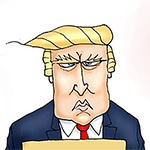Commentary: How do we help America's national parks? Make global visitors pay more
Published in News & Features
This summer, millions of people from around the world will visit America’s national parks, eager to marvel at iconic landscapes such as the Grand Canyon, Yosemite Valley and Old Faithful. These places aren’t just national treasures — they’re global ones. But the growing crowds and aging infrastructure in many parks tell a difficult story: Awe has an upkeep cost, and we’re not keeping up.
That’s why a recent presidential executive order calling for differential pricing for nonresident visitors to national parks couldn’t come at a better time. By increasing entrance fees for international visitors — many of whom are already accustomed to paying more to visit parks in other countries — we can generate millions of dollars dedicated to helping our national parks sustain operations, handle routine maintenance and protect the resources that make these places extraordinary in the first place.
This isn’t a punitive measure. It’s a smart strategy to sustain our most treasured public lands for visitors of all types.
Many national parks are under real strain. Visitation is soaring — topping 331 million recreation visits last year, a figure nearly equal to the U.S. population — while for years and across many presidential administrations, park budgets have been stagnant and gradually eroded by inflation. Trails and roads, bathrooms and visitor centers, and water systems and other essential infrastructure are aging and overburdened.
Nationwide, parks face an estimated $23 billion backlog of overdue maintenance. Without adequate support, even basic maintenance becomes harder to fund. While Congress provided a critical infusion of funding to address some of the most pressing deferred maintenance needs through the Great American Outdoors Act’s Legacy Restoration Fund, parks still need reliable resources to avoid digging that hole deeper.
International visitors can and should be part of the solution. They represent a meaningful share of park tourism — particularly at marquee destinations such as Yellowstone, Yosemite and Glacier. Yet under the current fee structure, they pay the same standard $35 per vehicle entrance fee as U.S. residents — or even less. Visitors arriving by commercial tour bus, for example, often pay just a fraction of that amount: The fee is $300 per bus, which can be spread across 50 or more passengers.
Meanwhile, American taxpayers contribute to the national park system not only through entrance fees, which are retained by parks, but also through federal income taxes that help fund park operations. In effect, international visitors, who are typically one-time or infrequent guests, often pay less than the U.S. citizens who help sustain the system year after year.
The concept of differential pricing is already common in countries from Costa Rica to South Africa and beyond, where foreigners pay more to help subsidize local access, maintain quality visitor experiences, and even fund community development and conservation projects outside park boundaries. And in other aspects of U.S. outdoor recreation, such as state park entry fees, campground reservations, and hunting and fishing licenses, pricing varies depending on whether you’re a local or nonresident.
Our national parks should be no exception, and that’s now changing.
The executive order from President Donald Trump directs the Interior Department to establish differential pricing for nonresidents to generate revenue to improve and enhance parks. The strategy aligns park funding with usage while preserving affordable access for American families. And it helps provide a sustainable, user-supported funding stream that will be reinvested directly into park stewardship, not siphoned off for unrelated uses.
Some might worry that the policy will make international tourists feel unwelcome or deter their travel. But a crumbling park does far more to make international visitors feel unwelcome than a surcharge ever could.
Moreover, if the goal is to generate as much revenue as possible for parks from the proposal, then the best strategy would be to welcome as many foreign visitors to our national parks as possible. And evidence suggests that paying an entrance fee doesn’t dampen visitors’ enjoyment of their visit. Indeed, the vast majority of international visitors would not be deterred by higher gate fees. Recent research from the Property and Environment Research Center estimates that a $100 surcharge per foreign visitor to Yellowstone would raise an additional $55 million— roughly four times the current entry fee revenue — while reducing total visitation by just 1.3%.
The reality is that many international visitors are not only able but also happy to pay a reasonable fee to help protect the places they visit, especially when they know the money stays in the park and supports its management and conservation, and when they seek an experience available nowhere else such as taking in the awe-inspiring view from the rim of the Grand Canyon. Rather than relying solely on taxpayer appropriations, which are subject to change, differential pricing gives parks a more sustainable, user-supported revenue stream.
The next steps will be to implement the policy thoughtfully, with clear and strategic communication to visitors. Research shows that highlighting visitor benefits, such as better-maintained trails, and showing improved outcomes can increase visitor support for fee increases. In the bigger picture, this shift reflects a welcome turn toward stewardship-focused strategies.
Parks offer an incredible value to Americans: $35 for a week at Yellowstone is less than a family in most U.S. cities pays for a two-hour trip to the movie theater. And by asking those who come from far away — often with higher travel budgets — to contribute a bit more, we can ensure that America’s national parks remain beautiful, accessible and resilient for generations to come.
National parks are a gift to the world, but they’re also a responsibility. If we want future generations — American and international — to enjoy the same sense of wonder that draws millions to our parks each year, we need to find smart ways to fund their care. Asking international visitors to contribute a fair share is a reasonable and long-overdue step in that direction.
____
Tate Watkins is a research fellow at the Property and Environment Research Center who studies the federal recreation fee system and national parks policy. Sharon Suiwen Zou is an assistant professor in the Department of Recreation, Sport and Tourism at the University of Illinois at Urbana-Champaign who has researched fee systems of parks and protected areas around the world.
_____
©2025 Chicago Tribune. Visit at chicagotribune.com. Distributed by Tribune Content Agency, LLC.







Comments